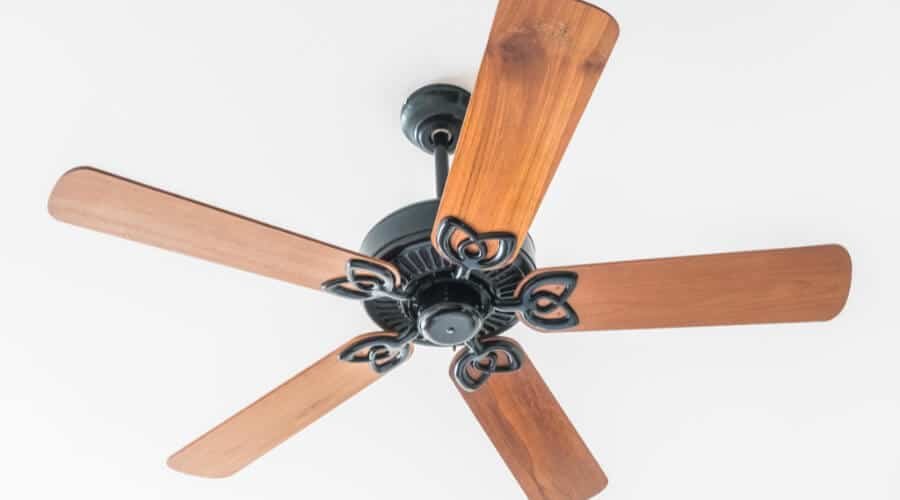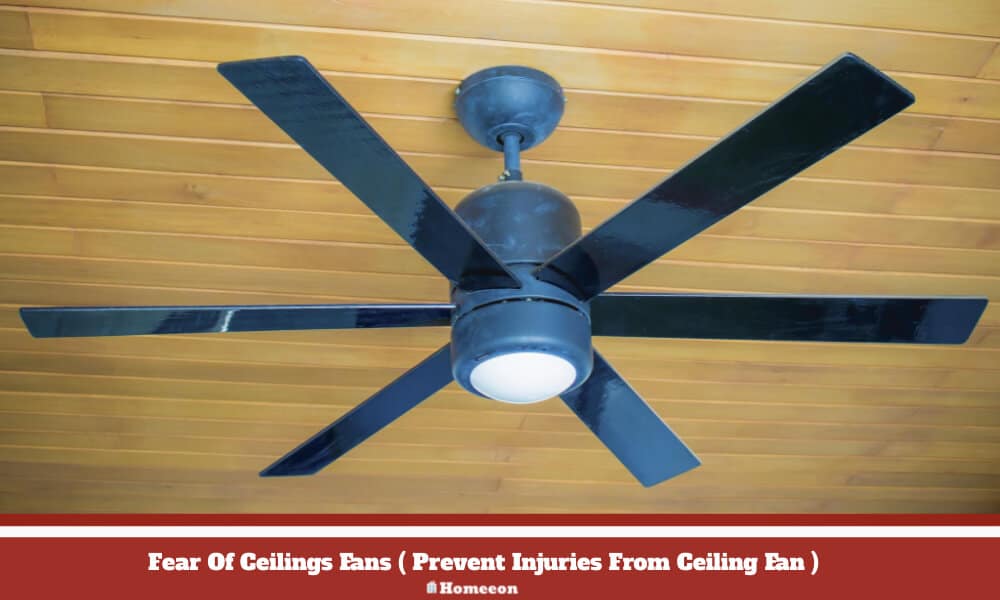Last Updated on July 25, 2023 By Emma W. Thomas
The fear of ceiling fans is called “Anemophobia.” It is an irrational and persistent fear that can cause anxiety or panic attacks when exposed to ceiling fans. Those experiencing anemophobia may seek therapy or counseling to manage and overcome their fear.
Safety Measures To Prevent Ceiling Fans From Falling

While ceiling fans rarely fall (and when they do, they cause little or no harm), there is a need to observe some safety measures, which include;
Purchase The Right Fan

Different ceiling fans are suited for diverse environments, and there is a need to pick the right one for you. Ensure that the fan’s features are in the right place. For example, if your office or house is in a wet location, look for a device that won’t rust.
Most fans cannot be used outdoors since rust, heat, and humidity will damage them. It is advisable to look for the devices rated as ‘WET’ if you want to use the outdoors or in your bathroom. WET-rated fans have UV-resistant blades, sealed motors, and they are also made of non-rust materials.
Consider The Correct Height And Clearance
One of the most vital factors to think of when fixing a ceiling fan is the room’s height. A ceiling fan that is too close to the floor will get in the way of walking persons and other items, leading to disturbances. If a person or an object touches or hits the fan, it may get damaged or be forced to fall.
Since the average height of a human adult is about 5.9 feet, fixing a ceiling fan higher than this makes it safe. As a rule of thumb, mounting this device 8-10 feet from the ground ensures the free movement of humans around the house.
Ensure that the tool has enough clearance and that its blades are far from the wall. The ideal distance between the wall and your device should be at least 18 inches.
Ensure The Screws Are Tight
Most ceiling fans fall as a result of loose screws. Be sure to tighten the screws when mounting the device or any time you notice wobbling. While it may not be necessary to call an expert or have special skills, be careful when undertaking the task. Ensure that the equipment is unplugged from the power source or switched off, then tighten it carefully with a screwdriver.
Clean the fan (if need be) and tighten all the screws that are visible and which connect different components. Use a hand screwdriver for a home fan or an electric one when fixing a sizeable industrial fan. Check if the problem is fixed by switching on the device.
Proper Maintenance
Like other home appliances, your ceiling fan needs proper and regular maintenance. Inspecting your fan every six months helps to notice any defects and fix them before it is too late. Doing this also helps to prevent an accident before it happens. Frequent maintenance will enhance the fan’s durability.
The following tips help in maintaining your fan in good condition;
Cleaning
Cleaning your fan twice a year will help to keep it in good condition for an extended period. You can use a ladder or step on a stool to reach the device. Clean the blades using a soft brush and remove any stains with a soapy wet cloth. Remove any dust from the motor by vacuuming it. Doing this will help to prevent rusting.
Lubricating
After cleaning the fan, it is necessary to lubricate it for the movable parts to remain functional for a long. Lubricating the machine will also help to protect the vital elements from wearing out. Ensure to fill the oil to the brim and wipe out any excess with a soft cloth. Repeat this process after every two months.
Check The Mechanics
The mechanical functioning of your fan is very crucial and needs to be checked at least once every year. Make sure the screws are tight and that the blades are well-balanced. Using a fan balance kit helps to do this task to ensure the fan does not wobble.
Ensure that your fan moves in the right direction, as this will determine proper heat and air distribution throughout the house. Experts advise that fans should move in a clockwise direction in the winter and counterclockwise in the summer.
Hire An Expert To Fix Your Ceiling Fan
While it may sound easy to install a ceiling fan, it is a complicated task. Hiring an expert helps to ensure the safety of your fan. A professional will check the length and weight of the blades and also the motor’s speed. These factors determine the force exerted on the edges and the momentum of the fan. The fan’s momentum and the design’s capability to support it will dictate the device’s safety.
Although hiring the services of a professional may cost a few dollars, it helps to enhance safety. These experts are trained and certified to perform the task and will be sure to have the tool adequately installed. You can look for a firm or an interior installations agency that deals with such charges since they will install your fan and give a warranty.
Is It Possible For A Running Ceiling Fan To Fall?

A ceiling fan can fall or not, but this depends on its installation. The probability of a running ceiling fan dropping also depends on other factors such as its weight, the blades’ mass, the machine’s rotations per minute, and gravitational pull. The down rod and mounting bracket need also to be strong enough to support the fan’s weight.
Can A Falling Ceiling Fan Kill An Adult?
An ordinary ceiling fan weighs around 6-15Kg (15-35 pounds). If the machine falls from 8-feet above the ground, it will exert a force of between 60 and 150 Newton. Even if this fan falls on a standing adult, it can only hurt and not kill them. For a falling object to kill an adult, it would require a force exerted by 1,100 pounds (500 kilograms) on standard gravity.
However, you must take crucial precautions to ensure that your fan does not drop.
What Are The Main Components Of A Ceiling Fan That Can Cause Injury?
A defective ceiling fan has the potential of falling and injuring both humans and pets in a home or office. The functionality of the major components of the fan will influence its defects. Here are some of these components;
Electric Motor
Among the most crucial parts of a fan is the motor since it transforms electric power into motion. The engine allows the electric current to flow through it, making it produce mechanical energy, and in turn, it rotates the blades. This part is primarily metallic and the heaviest in a fan, and its size varies depending on the application.
If the motor is faulty, the fan will not rotate properly, leading to its falling.
Fan Blades
Standard ceiling fans come with 2 to 6 blades made from metal, plastic, or wood. These edges are sized and weighted to accuracy, with heavy fans having fewer blades than lighter units. Most large industrial fans have 2 or 3 blades, while home ceiling fans have 4 to 6.
Down Rod
A down rod is a bar that suspends the fan from high ceilings. It is made of metal, plastic, or wood, and it plays a significant role in ensuring the safety of a fan. Its strength regulates the stability of the fan and determines whether it will fall or not.
Blade Brackets
These parts are metallic, and they connect the blades to the motor.
Lights
Modern fans also come with light fixtures located either inside, above, or below the motor. These lights run on electricity, like the motor, and they can be replaced often.
How To Tell That Your Ceiling Fan Is Defective
There are some signs that you can look for to tell that your ceiling fan is faulty, including;
Production Of Noise
Although a fan makes noise when operating, the excess sound indicates some defects. If your ceiling fan is loud when running, it may mean loose connections in the unit, its components, or the box. When the fan rotates, any loose parts clank together, causing a loud noise.
Ball bearings responsible for rotating the fan’s blades could also make the fan produce a grinding sound due to friction. Be sure to clean and lubricate these parts adequately for proper function.
Flickering Lights
Modern fans have lights, and when you see them flickering, it is a sign that the bulbs need a replacement. Flickering lights may also indicate a loose connection with the fixture or bulb, or there could be a fluctuation in voltage.
Wobbling
A wobbling fan could be a sign of damaged blades, a poor-quality device, or wrongly installed fans. If there is a loose connection or bent in the box screws, blade brackets, down rod, or other joined parts, the fan will wobble.
Fan Failure To Turn On
Your fan may fail to turn on or stop working if it is not receiving any electricity. If the circuit breaker is off or it has tripped, it could lead to this problem. The problem could also be due to a loose connection or wiring. An overheated motor or faulty shot ball bearing could also lead to the fan not working.
Ensure that you call in an expert to fix these issues when you notice them to prevent the fan from falling and prevent any damage.
Wrapping Up
While the fear of a ceiling fan (known as fan phobia) may be a psychological condition, it is necessary to prevent its occurrence. Proper installation and maintenance will help to avert any injuries.
References:
https://topceilingfans.net/fear-of-ceiling-fans/
https://www.quora.com/What-is-the-fear-of-ceiling-fans-called
Emma is a graduate of Domestic Science or Family and Consumer Sciences (Home Economics) from the University of Wisconsin. She has 7 years of experience Working with the strategic section of BestBuy and now writing full-time for Homeeon.
From Managing the Home, Interiors, Cleaning, and Exteriors to Gardening and everything about Making A Home Liveable – is her passion and this Homeeon is the result of this.
Emma loves decorating her home with the best stuff found online. She cares about quality over anything and writes reviews about them here in Homeeon. Get in touch with her over Pinterest.
Keep reading her blogs.
